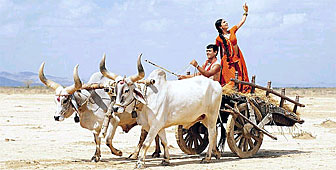Locarno festival screens Indian films

Two films from India have contrasted different aspects of the world's second biggest producer of movies at the international film festival in Locarno. One Indian film was commercial and bombastic, while the other was restrained. But both films were melodramatic.
“Lagaan – Once Upon a Time in India” by star director Ashutosh Gowariker, a multi-million dollar production from one of Bombay’s big commercial studios, was screened at the festival’s prime venue in the Piazza Grande on Sunday before an audience eager to experience culture shock.
The festival is known to sympathise with films that surprise, experiment, are made cheaply, or feature sophisticated stories – but a “Bollywood” film over three and a half hours long? “Lagaan” flamboyantly lacks any of the attributes mentioned.
The fictional story is set in 1893 in a village ravaged by drought and oppressed by a British garrison. When one of the officers proposes a bet and promises that a stifling tax will be abolished if the villagers beat the military at a cricket match, the film’s hero, Bhuvan (Aamir Khan), accepts.
Success in the Piazza Grande
Against the odds, he builds a village team – and, of course, beats the British at their game. Add a couple of similarly simple but potent side stories of love and treason, throw in choreographed dance scenes at regular intervals – and you’ve got all the ingredients to attract millions to India’s favourite pastime, movie-going.
Maybe not that surprisingly, the film was a success in the Piazza Grande. There was a lot of ironic laughter. Judging from the applause whenever the British lost a wicket, the audience quickly took sides and become fervent Indian nationalists.
Compared to “Lagaan”, India’s entry in the official competition for the golden leopard award of best film is a quiet film.
“Mankolangal” by Subrahmanian Santakumar doesn’t look back on heroic deeds of the past, but casts a troubled look into the future. It depicts a rural community where farmers are used to supplementing their income with making pots. But the potery trade has been thrown into crisis due to the production of cheap plastic pots and vats.
Social comment
Santakumar, who is 24, has said in interviews that he wants his film to reflect the negative aspects of globalisation, but this fashionable gloss doesn’t ring true – plastic pots are made in India and not imported. The film does manage to describe the structural changes that come with development and the turmoil they can bring to people’s private lives.
In another sense “Mankolangal” works well as the critical social comment it sets out to be. Its main protagonist, Alagiri, leads an unconventional life as a single man who refuses to take on responsibility as a husband and father. Even though he sees more clearly than his neighbours what lies at the origin of their woes, he has difficulty convincing them because he can be comfortably ridiculed as an outcast.
Although different in style and intention, “Mankolangal”, like “Lagaan”, is rooted in the tradition of Indian film and its expressionist description of love, sorrow and morality in their most uncompromising forms.
by Markus Haefliger

In compliance with the JTI standards
More: SWI swissinfo.ch certified by the Journalism Trust Initiative
You can find an overview of ongoing debates with our journalists here . Please join us!
If you want to start a conversation about a topic raised in this article or want to report factual errors, email us at english@swissinfo.ch.